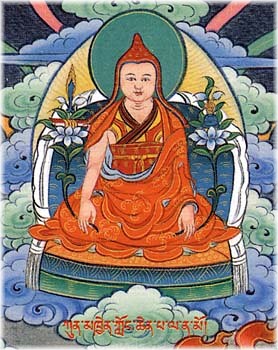Treasury of Philosophical Tenets: Difference between revisions
Jump to navigation
Jump to search
(New page: '''Treasury of Philosophical Tenets''' (Tib. drubta dzö; Wyl. grub mtha' mdzod) - One of the Seven Treasuries of Longchenpa. Category:Seven Treasuries Category:Texts) |
mNo edit summary |
||
| (8 intermediate revisions by 3 users not shown) | |||
| Line 1: | Line 1: | ||
'''Treasury of Philosophical Tenets''' (Tib. | [[Image:Longchenpa from 12.jpg|thumb|[[Longchen Rabjam]]]] | ||
'''Treasury of Philosophical Tenets''' (Tib. གྲུབ་མཐའ་མཛོད་, ''Drubta Dzö'', [[Wyl.]] ''grub mtha' mdzod'') — one of the [[Seven Treasuries]] of [[Longchenpa]]. | |||
==Outline== | |||
This treasure, in 8 chapters, is divided into common and esoteric uncommon sections: | |||
#How the Buddha came into this world (based on [[hinayana]], [[mahayana]], and tantric accounts); the [[twelve acts of the Buddha]]; the "turning the wheel of the Dharma". | |||
#The Teachings; [[Shakyamuni]]'s teachings, and the commentarial traditions. | |||
#Philosophical Tenets, based upon these teachings, including: outsiders (non Buddhists) and insiders (Buddhists). The Buddhist views include: [[Vaibhashika]], [[Sautrantika]], [[Yogachara]], and [[Madhyamika]]. | |||
#The Way to progress on the Path (Wyl. ''lam bgrod tshul''), including the approach of the [[Shravaka]], [[Pratyekabuddha]], and [[Bodhisattva]], and an account of the [[five paths]]. | |||
#An account of the secret mantrayana as the Fruition, including the special characteristics of [[Vajrayana]]. | |||
#An account of How the Vajrayana Teachings Came About, including the New Tantra ([[Sarma]]) definitions, and classifications. | |||
#An account of The Ancient Tradition ([[Nyingma]]) definitions and classifications, divided into three general tantras ([[kriya tantra|kriya]], [[charya tantra|upa]], [[yoga tantra|yoga]]), and three inner tantras ([[mahayoga]], [[anuyoga]], [[atiyoga]]). | |||
#An account of the Esoteric Approach, being the Vajra Essence of Luminosity, including a general discussion of: How the ground of Being naturally abides; the way in which sentient beings go astray, the way in which sentient beings can practise, and then finally achieve the fruition of freedom. | |||
==Tibetan Text== | |||
* {{TBRCW|O1PD14|O1PD1474$W1PD8|ཐེག་པ་མཐའ་དག་གི་དོན་གསལ་བར་བྱེད་པ་གྲུབ་མཐའ་རིན་པོ་ཆེའི་མཛོད་, ''theg pa mtha' dag gi don gsal bar byed pa grub mtha' rin po che'i mdzod''}} | |||
==Translations and Commentaries== | |||
*Longchen Rabjam, ''Precious Treasury of Philosophical Systems'', translated by Richard Barron, Padma Publishing, 2007 | |||
*Albion Moonlight Butters, ''The Doxographical Genius of Kun mkhyen kLong chen rab 'byams pa'', Columbia University, 2006 | |||
[[Category:Seven Treasuries]] | [[Category:Seven Treasuries]] | ||
[[Category:Texts]] | [[Category:Texts]] | ||
[[Category:Longchenpa]] | |||
[[Category:Philosophical Tenets]] | |||
Latest revision as of 13:45, 8 December 2020

Treasury of Philosophical Tenets (Tib. གྲུབ་མཐའ་མཛོད་, Drubta Dzö, Wyl. grub mtha' mdzod) — one of the Seven Treasuries of Longchenpa.
Outline
This treasure, in 8 chapters, is divided into common and esoteric uncommon sections:
- How the Buddha came into this world (based on hinayana, mahayana, and tantric accounts); the twelve acts of the Buddha; the "turning the wheel of the Dharma".
- The Teachings; Shakyamuni's teachings, and the commentarial traditions.
- Philosophical Tenets, based upon these teachings, including: outsiders (non Buddhists) and insiders (Buddhists). The Buddhist views include: Vaibhashika, Sautrantika, Yogachara, and Madhyamika.
- The Way to progress on the Path (Wyl. lam bgrod tshul), including the approach of the Shravaka, Pratyekabuddha, and Bodhisattva, and an account of the five paths.
- An account of the secret mantrayana as the Fruition, including the special characteristics of Vajrayana.
- An account of How the Vajrayana Teachings Came About, including the New Tantra (Sarma) definitions, and classifications.
- An account of The Ancient Tradition (Nyingma) definitions and classifications, divided into three general tantras (kriya, upa, yoga), and three inner tantras (mahayoga, anuyoga, atiyoga).
- An account of the Esoteric Approach, being the Vajra Essence of Luminosity, including a general discussion of: How the ground of Being naturally abides; the way in which sentient beings go astray, the way in which sentient beings can practise, and then finally achieve the fruition of freedom.
Tibetan Text
 ཐེག་པ་མཐའ་དག་གི་དོན་གསལ་བར་བྱེད་པ་གྲུབ་མཐའ་རིན་པོ་ཆེའི་མཛོད་, theg pa mtha' dag gi don gsal bar byed pa grub mtha' rin po che'i mdzod
ཐེག་པ་མཐའ་དག་གི་དོན་གསལ་བར་བྱེད་པ་གྲུབ་མཐའ་རིན་པོ་ཆེའི་མཛོད་, theg pa mtha' dag gi don gsal bar byed pa grub mtha' rin po che'i mdzod
Translations and Commentaries
- Longchen Rabjam, Precious Treasury of Philosophical Systems, translated by Richard Barron, Padma Publishing, 2007
- Albion Moonlight Butters, The Doxographical Genius of Kun mkhyen kLong chen rab 'byams pa, Columbia University, 2006